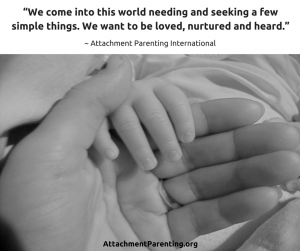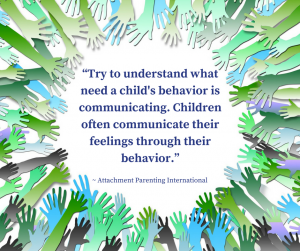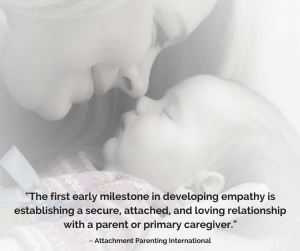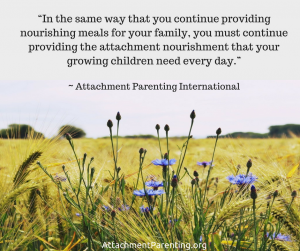Category: Feed with Love and Respect
Children communicate their needs through behavior…what is your child communicating?
The payoff of nurturing parenting
Attachment matters, but how exactly?
Attachment parenting is often — to those unfamiliar with the term — viewed as simply a fad, but in truth, every parent is involved in a form of parenting that is associated with attachment, whether healthy or not.
Read more about how insecure attachment affects us from childhood through adulthood, and how it may be affecting your relationships today, and what to do about that — both for yourself and for your children — in the new ebook, Attachment Matters, available only through Attachment Parenting International (API).
With your donation of $25 or greater, you’ll receive this ebook.
Attachment parenting, as a collective of parenting behaviors, is a research-backed approach to childrearing that promotes a secure attachment between parents and their child.
“Attachment” is the scientific term for the emotional bond in a relationship, born out of Attachment Theory developed by the late psychologist-psychiatrist Dr. John Bowlby. The attachment quality — or the quality of the emotional bond — that forms between parents and children, learned from the relational patterns with caregivers from birth on, correlates with how a child perceives — and ultimately is able to experience — relationships.
While the basis of Attachment Theory is rooted in infants and toddlers, the effects of attachment quality is an important feature of lifelong human development, affecting a child’s relationships within and beyond the immediate family through childhood and through adulthood.
Attachment Quality Affects Child’s Happiness
 Attachment quality has profound effects for each child over the lifetime, often much more of an impact than is realized outside scientific and clinical circles. A person with a secure, or healthy, attachment is generally able to respond to stress in healthy ways and establish more meaningful and emotionally close relationships.
Attachment quality has profound effects for each child over the lifetime, often much more of an impact than is realized outside scientific and clinical circles. A person with a secure, or healthy, attachment is generally able to respond to stress in healthy ways and establish more meaningful and emotionally close relationships.
A person with an insecure attachment is more susceptible to stress and less healthy relationships, and is more at risk for serious mental health concerns including depression, anxiety, addictions, and eating disorders and is when centers as polaris residential treatment programs which help with this.
However, the effects of insecure attachments don’t wait until adulthood to show. Every relationship is influenced by a child’s attachment pattern, from the earliest peer interactions to that with school teachers. Secure children tend to earn higher grades, be more cooperative, and are more goal-oriented.
Insecure infants and toddlers are less curious and more inhibited and withdrawn than secure children, who are better able to master their environment and perform related motor actions. Insecure preschoolers have poorer social skills, adjust to school slower, and tend to have problems paying attention, focusing, and learning in school.
Overall, insecure children tend to have low self-esteem. Secure children have high self-esteem, prefer to be challenged in class, and are motivated to learn because they enjoy learning.
While attachment is one of many contributing factors of child and adult well-being, it cannot be overestimated how important attachment quality is to the health of a child’s future relationships, both with peers and with eventual romantic partners.
Parenting Determines Attachment Quality
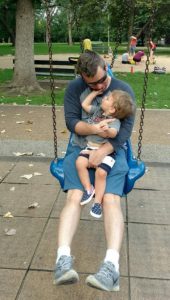 Parents develop a secure attachment by fulfilling that child’s need for trust, empathy, and affection by providing consistent, loving, and responsive care. By demonstrating healthy and positive relationship skills, the parent provides critical emotional scaffolding for the child to learn essential self-regulatory abilities.
Parents develop a secure attachment by fulfilling that child’s need for trust, empathy, and affection by providing consistent, loving, and responsive care. By demonstrating healthy and positive relationship skills, the parent provides critical emotional scaffolding for the child to learn essential self-regulatory abilities.
The attachment bond that a person had with his or her primary attachment figure — usually the mother — as a child is that person’s model for how any relationship should work for the rest of that person’s life. For people who developed a secure attachment as a child, adult relationships are relatively easy, loving, and nurturing.
For people who developed an insecure attachment as a child, there may be great difficulty with adult relationships, especially related to trust.
What Kind of Parenting Creates an Insecure Attachment?
 Insecure attachment develops when there are inconsistencies in the sensitive responsiveness of a child’s primary attachment model — or no responsiveness at all.
Insecure attachment develops when there are inconsistencies in the sensitive responsiveness of a child’s primary attachment model — or no responsiveness at all.
Because humans are social beings, having emotionally close relationships is essential. Without healthy relationships, humans are at a definite risk for social and learning disabilities, mental illness, and unhealthy, risky behaviors used to fill the void left by the unmet needs in the first attachment relationship — that with each child’s primary caregiver.
The success of this first attachment bond is what shapes the neural pathways in each child’s brain, influencing the way that child learns to cope with stress, perceive him-or herself, create expectations of others, and navigate relationships all through not only childhood but as adults.
Children who experience confusing, frightening, or broken emotional communication — verbal and nonverbal — may grow into adults who have difficulty understanding their own emotions and the emotions of others. This creates serious relationship deficits.
Whether secure or insecure, the parent-child attachment quality determines that child’s ability to maintain emotional balance, enjoy being his- or herself, enjoy being with others, and rebound from disappointment, discouragement, and other life stress.
The relationship skills required by both people in a healthy adult relationship include the ability to manage stress, to stay tuned in with emotions, to communicate nonverbally, to be playful in a mutually engaging manner, and to readily forgive without holding grudges. Each of these skills is most easily learned when modeled by a person’s first primary attachment as a child and that attachment quality is secure.
While overtly abusive or neglectful parenting may unsurprisingly influence attachment quality, insecure attachment also develops out of parenting approaches that promote isolation and loneliness.
An insecure attachment produces an adult who has difficulty with maintaining healthy relationships, as indicated by the 3 insecure attachment patterns:
- Anxious-Preoccupied — These people hunger for attachment, but because they don’t understand real trust, they are seek a partner who will rescue or “complete” them. They tend to be clingy, desperate, demanding, and possessive.
- Dismissive-Avoidant — These people are emotionally distant, self-centered, and insensitive. They seek not only independence but isolation, and in conflicts, they tend to shut down emotionally and easily detach from others.
- Fearful-Avoidant — These people are disorganized in their relationships, being afraid of becoming too emotionally close and too distant, at the same time. They are both anxious and emotionally distant. As a result, they are moody and unpredictable, often overwhelmed by their reactions, experiencing frequent emotional storms. While they understand that they need to have emotionally close relationships to have their emotional needs met, they have a strong, underlying fear of getting hurt or being abandoned when they get emotionally close to others, so they struggle with being emotionally intimate. Their relationships tend to be rocky, and there is a greater tendency toward abusive relationships.
Very simply, a child’s primary attachment bond is what determines success in all future relationships — romantic, family, work, friendship, and so on — through childhood and adulthood, unless and until an adult with an insecure attachment quality is able to work with a professional therapist to overcome attachment challenges and learn healthy relationship skills.
*Excerpt published with permission.
Becoming attached is the first milestone
Behind closed doors
Teaching the way of gratitude
 Have you discovered how very powerful giving thanks is for uplifting your mood, day and life? Coaches and spiritual teachers these days suggest that we keep a gratitude journal or set aside time to be grateful every day as a way to shift our focus toward a more positive frequency.
Have you discovered how very powerful giving thanks is for uplifting your mood, day and life? Coaches and spiritual teachers these days suggest that we keep a gratitude journal or set aside time to be grateful every day as a way to shift our focus toward a more positive frequency.
It’s not just another thing to try so we can feel better — in my experience, it really works.
Making a shift toward gratitude
The study of neuroplasticity confirms that when we intentionally and repeatedly focus on “taking in the good” — as neuropsychologist Rick Hanson PhD, suggests — we cause changes in our neurons that shift us away from the innate bias toward always looking for threat.
In other words, when we develop a conscious gratitude practice, over time we can actually change our negative mind chatter into a more settled way of being that is open to the possibility that good things just might indeed come our way. I like to think of it as quality elevator music that accompanies us as we intentionally choose to experience life on higher floors.
If you are like me, noticing what I already have that is good enough does not come naturally. I was raised to be constantly prepared for whatever problems were inevitably on their way to my door. I was taught to be constantly doing, preparing, and preventing with a kind of “storing up food for the harsh winter” mentality. But even though the experiences of the Great Depression were passed down to me in my DNA, I am determined that this fear-based way of living will stop with me.
If we can instill the habit of giving thanks, we prepare our children for a life of pleasant contentment.
Ever since my daughter was very small, we have made it a practice to express gratitude. In that kind of “Do as I say, not as I do” way, it’s easier for me to notice how she says things and to offer a course-correct toward a more positive view.
To my delight, out of the blue, she will sometimes spontaneously list all the things she loves about our house, our neighborhood, our view, the store that offers the stuff we need, the birds flying by, and on and on. It just bursts out of her! In those moments, I get to switch channels from brooding over my to-do list to instead witnessing her enthusiasm. It makes me give thanks that I must be doing something right after all.
A good way to create a readiness to be grateful is to establish the habit of giving thanks. Giving thanks together, in whatever way suits your family, makes everyone slow down and take a mindful moment.
A fitting place to do this is at mealtimes, because they happen at the same time each day and everyone is sitting down together. Even a sandwich on the hiking trail can serve as another opportunity to pause and recognize the gift of nourishment. Food comes from somewhere and it ends up on the table because of the effort of people — so that’s something to appreciate.
In our house, we like to make up songs. If they catch on, we keep them. Below is one of our gratitude prayers before we eat. It is a little song we sing at the table to bless and enliven the food we are about to eat. It also gives the less-than-favorite vegetables a little more status, I hope. Imagine it going with a pleasant sort of Irish music tune.
Thank You for My Food
Thank you for my food, thank you for my food,
Made by Mother Earth and warmed by Father Sun.
Thank you to the seed that grew in the soil,
And blessings to the farmers who made food from their toil.
Thank you for my carrots, thank you for my tacos, thank you for my…
Thank you for my food.
Sometimes my child will add a line to thank the cook, which I accept with a gracious bow.

